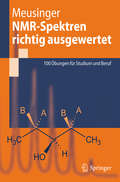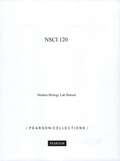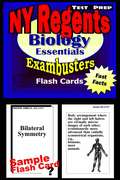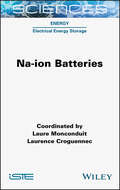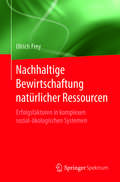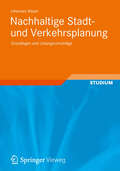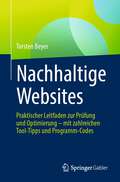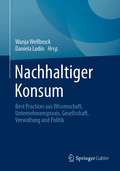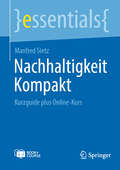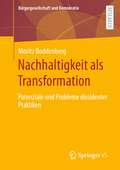- Table View
- List View
NMR-Spektren richtig ausgewertet
by Reinhard MeusingerDer Band enthält 100 praxisnahe und verständliche Beispiele und Übungen zur korrekten Auswertung von ein- und zweidimensionalen NMR (Nuclear Magnetic Resonance)-Spektren. Alle gängigen Problemstellungen der Spektrenauswertung werden behandelt. Außerdem enthält das Buch eine Liste der wichtigsten Spektrenparameter sowie viele praktische Hinweise. Alle Beispiele und Übungen haben sich in Kursen des Autors bewährt. Sie sind nach verschiedenen Schwierigkeitsgraden ausgewählt und insbesondere auch für das Selbststudium geeignet.
NSCI 120: Modern Biology Lab Manual
by DickeyScientific inquiry is a particular way of answering questions. It can’t be used for all types of questions. The questions that can be answered by science must meet specific guidelines and scientific investigations must be carried out using certain rules. When an investigation is designed properly and meets these guidelines, then the results are acceptable to other scientists and are added to the body of scientific knowledge. If an investigator cannot show that his or her experiment was done according to the guidelines, then the results of that experiment will not be recognized as valid by other scientists.
NY Regents Exam Test Prep Flash Cards: Biology Essentials (Exambusters NY Regents Workbook #2)
by Ace Inc.<P><P><i>Advisory: Bookshare has learned that this book offers only partial accessibility. We have kept it in the collection because it is useful for some of our members. Benetech is actively working on projects to improve accessibility issues such as these.</i><P><P> 450 questions and answers. Essential definitions and concepts.<P><P> Topics: Cells, Biochemistry and Energy, Evolution and Classification, Kingdoms: Bacteria, Fungi, Protista; Kingdom: Plantae, Kingdom: Animalia, Human Locomotion, Human Circulation and Immunology, Human Respiration and Excretion, Human Digestion, Human Nervous System, Human Endocrinology, Reproduction and Development, Genetics, Ecology <P>"Exambusters NY Regents Prep Workbooks" provide comprehensive NY Regents review--one fact at a time--to prepare students to take practice NY Regents tests. Each NY Regents study guide focuses on fundamental concepts and definitions--a basic overview to begin studying for the NY Regents exam. Up to 600 questions and answers, each volume in the NY Regents series is a quick and easy, focused read. Reviewing NY Regents flash cards is the first step toward more confident NY Regents preparation and ultimately, higher NY Regents exam scores!
NY Regents Exam Test Prep Flash Cards: Physics Essentials (Exambusters NY Regents Workbook #4)
by Ace Inc.<P><P><i>Advisory: Bookshare has learned that this book offers only partial accessibility. We have kept it in the collection because it is useful for some of our members. Benetech is actively working on projects to improve accessibility issues such as these.</i><P><P> 600 questions and answers. Essential definitions, formulas, concepts, and sample problems. <P><P>Topics: Measurement, Motion and Forces, Work and Energy, Heat and Gases, Atoms, Fluids, Sound, Light and Optics, DC Circuits, Magnetism, AC Circuits <P>"Exambusters NY Regents Prep Workbooks" provide comprehensive NY Regents review--one fact at a time--to prepare students to take practice NY Regents tests. Each NY Regents study guide focuses on fundamental concepts and definitions--a basic overview to begin studying for the NY Regents exam. Up to 600 questions and answers, each volume in the NY Regents series is a quick and easy, focused read. Reviewing NY Regents flash cards is the first step toward more confident NY Regents preparation and ultimately, higher NY Regents exam scores!
NY Regents Test Prep Flash Cards: Chemistry Essentials (Exambusters NY Regents Workbook #3)
by Regents Exambusters700 questions and answers. Essential definitions, formulas, concepts, and sample problems.<P><P> Topics: Introduction, Matter, Atoms, Formulas, Moles, Reactions, Elements, Periodic Table, Electrons, Chemical Bonds, Heat, Gases, Phase Changes, Solutions, Reaction Rates, Equilibrium, Acids and Bases, Oxidation and Reduction, Introduction to Organic Chemistry, Radioactivity <P>"Exambusters NY Regents Prep Workbooks" provide comprehensive NY Regents review--one fact at a time--to prepare students to take practice NY Regents tests. Each NY Regents study guide focuses on fundamental concepts and definitions--a basic overview to begin studying for the NY Regents exam. Up to 600 questions and answers, each volume in the NY Regents series is a quick and easy, focused read. Reviewing NY Regents flash cards is the first step toward more confident NY Regents preparation and ultimately, higher NY Regents exam scores!
Na+H+ Exchange
by S. GrinsteinPrepared by leading scientists in the field, these volumes compile for the first time, concise, up-to-date reviews of several aspects of the basic properties, distribution, function and regulation of the Na+/H+ antiport. In addition, current methods and the use of inhibitors and ligands for the study of the exchanger are described. These volumes are indispendable to researchers and students in the areas of ion transport, membrane biology and cellular physiology.
Na-ion Batteries
by Laure Monconduit Laurence CroguennecThis book covers both the fundamental and applied aspects of advanced Na-ion batteries (NIB) which have proven to be a potential challenger to Li-ion batteries. Both the chemistry and design of positive and negative electrode materials are examined. In NIB, the electrolyte is also a crucial part of the batteries and the recent research, showing a possible alternative to classical electrolytes – with the development of ionic liquid-based electrolytes – is also explored. Cycling performance in NIB is also strongly associated with the quality of the electrode-electrolyte interface, where electrolyte degradation takes place; thus, Na-ion Batteries details the recent achievements in furthering knowledge of this interface. Finally, as the ultimate goal is commercialization of this new electrical storage technology, the last chapters are dedicated to the industrial point of view, given by two startup companies, who developed two different NIB chemistries for complementary applications and markets.
Nachhaltig mobil: Wie das Ruhrgebiet die Verkehrswende schaffen kann
by Johannes WeyerDas Buch enthält die Ergebnisse des Projekts InnaMoRuhr, in dessen Rahmen Konzepte nachhaltiger Mobilität erforscht und in mehreren Realexperimenten erprobt wurden. In einem ersten Schritt wurden die Daten einer Befragung sämtlicher Mitglieder der drei Ruhrgebiets-Universitäten Duisburg-Essen, Bochum und Dortmund genutzt, um bestehende Mobilitätsmuster zu identifizieren. Zudem wurden Mobilitätstypen identifiziert, deren Mobilitätsverhalten sich deutlich unterscheidet. Sie reagieren auch unterschiedlich auf Anreize, deren Ziel es ist, sie zu einer Änderung ihres Mobilitätsverhaltens zu bewegen. Die Zukunft der Mobilität stellen sich die meisten Menschen nachhaltig, flexibel und individuell vor. Dabei spielt das Fahrrad eine wichtige Rolle. Auf Basis dieser Daten und unter Rückgriff auf Konzepte der analytischen Soziologie wurde zudem ein Modell des Mobilitätsverhaltens entwickelt, das in der Lage ist, das reale Verhalten mit großer Treffsicherheit zu erklären. Im zweiten Schritt wurden Szenario-Workshops durchgeführt, um mehrere Szenarien zukünftiger Mobilität zu entwickeln, aber auch durch Kontrastierung mit fiktiven Personas auf ihre Alltagstauglichkeit zu testen. Die erfolgversprechendsten Szenarien wurden zudem in Simulationsexperimenten evaluiert und schließlich in drei Realexperimenten mit freiwilligen Probanden erprobt (Schritt 3). Dabei kam eine selbst entwickelte Mobilitäts-App zum Einsatz, die nicht nur Routing-Empfehlungen gab, sondern auch ein – anonymes – Tracking der Versuchsteilnehmer ermöglichte, ergänzt um Feedback-Funktionen, die reichlich genutzt wurden. Das Projekt InnaMoRuhr wurde vom Verkehrsministerium des Landes NRW gefördert und von einem interdisziplinären Konsortium durchgeführt, bestehend aus sechs Instituten der drei UA-Ruhr-Universitäten mit den Schwerpunkten Soziologie, Wirtschaftswissenschaften, Informatik und Energiesystemtechnik. Das Projekt hat gezeigt, dass diese Form der Zusammenarbeit einen großen Mehrwert generiert und zudem Impulse für die praktische Umsetzung von Konzepten nachhaltiger Mobilität geben kann.
Nachhaltige Bewirtschaftung natürlicher Ressourcen: Erfolgsfaktoren in komplexen sozial-ökologischen Systemen
by Ulrich FreyDieses Buch analysiert die wichtigsten Einflussfaktoren für das Management sozial-ökologischer Systeme. An vielen natürlichen Ressourcen betreibt der Mensch Raubbau. Dennoch gibt es Gegenbeispiele nachhaltiger Nutzung von Gemeingütern. Wichtige Fragen wie zum Beispiel: Was zeichnet erfolgreiche Nutzung aus? werden in diesem Buch beantwortet. Anhand von drei der weltweit größten Datensätze zu Fischerei-, Waldbewirtschaftungs- und Bewässerungssystemen werden Erfolgsfaktoren empirisch untersucht und für den Leser einzeln beleuchtet. Das Buch entwickelt über eine Bandbreite von Methoden – Regressionen, Entscheidungswälder und neuronale Netzwerke – prognosestarke und robuste empirisch fundierte Modelle,um ein neues Licht auf bereits häufig untersuchte Faktoren zu werfen, wie zum Beispiel Konfliktlösungsmechanismen. Der Autor stellt 24 Erfolgsfaktoren als Synthese aus seinen Modellen vor, die den ökologischen Erfolg in der Bewirtschaftung natürlicher Ressourcen sehr gut erklären.
Nachhaltige Entwicklung technischer Produkte und Systeme: Der Ingenieurberuf im Wandel
by Jürgen H. FranzDas Buch erläutert ausgehend vom Begriff der Nachhaltigkeit die Anforderungen an die Herstellung technischer Systeme. Es erklärt die Lebensphasen eines Produktes, die Rolle der Nachhaltigkeit in diesen Phasen und die sich daraus ergebenden Konsequenzen für den Ingenieur und die Ingenieurin sowie für die Ausbildung in den ingenieurwissenschaftlichen Studiengängen. Das Buch zeigt, dass durch die Anforderungen, welche die Nachhaltigkeit setzt, der Ingenieurberuf noch vielseitiger und spannender, aber auch verantwortungsvoller wird, als er ohnehin schon ist.
Nachhaltige Gestaltung von lokalen Ernährungssystemen durch Kommunalpolitik und -verwaltung (Stadtforschung aktuell)
by Arnim Wiek David Sipple Heiner SchanzDieses Open Access Buch erarbeitet konkrete Ansatzpunkte, wie die kommunale Praxis in Politik und Verwaltung Beiträge zur Ernährungswende Richtung Nachhaltigkeit leisten kann. Dabei wird u.a. aufgezeigt, dass die Aufgaben von Städten und Gemeinden, beispielsweise bei der öffentlichen Beschaffung, in Planungsfragen oder bei der Wirtschaftsförderung, bereits weit in ernährungsrelevante Bereiche hineinreichen und somit wichtige Hebelpunkte für nachhaltige Praktiken bestehen.
Nachhaltige Konzepte im stationären Handel: Eine Analyse des Ladenbaus (BestMasters)
by Lena StrokaEine unaufhaltsame Bewegung hin zu Nachhaltigkeit kann in den verschiedensten Branchen beobachtet werden. Auch im Bereich des Lebensmitteleinzelhandels (LEH) fordern Kund*innen und staatliche Behörden nachhaltige Maßnahmen ein. Der Wissensstand und die Praxis beziehen sich hierbei in erster Linie auf das Produktsortiment und die Lieferketten des LEHs. Dem Ladenbau, also speziell dem physischen Umfeld des Ladens, wird hingegen wenig Beachtung in diesem Kontext geschenkt. Das vorliegende Buch untersucht, mithilfe welcher Maßnahmen der Ladenbau im Einzelhandel umfassend nachhaltig gestaltet werden kann. Es hinterfragt zudem, welchen Stellenwert die Kommunikation des nachhaltigen Ladenbaus bei Kund*innen einnimmt, um potenzielle Motivationsfaktoren für Einzelhändler*innen und Ladenbauer*innen ableiten zu können.
Nachhaltige Marktwirtschaft: Die Soziale Marktwirtschaft des 21. Jahrhunderts (essentials)
by Wolfgang ViewegWolfgang Vieweg zeigt kompakt und allgemein verständlich, inwiefern die Soziale Marktwirtschaft für die heutige Zeit zu eng geworden ist und weshalb sie unbedingt einer Erweiterung bedarf. In Sachen Nachhaltigkeit hat Deutschland inzwischen eine umfängliche und leistungsfähige Infrastruktur aufgebaut. Nachhaltigkeit ist Chefsache in der Politik, hat einen hohen Stellenwert in den Unternehmen und Menschen ändern ihr Konsumverhalten. Der Autor zeigt, wie die aktuelle Weiterentwicklung von Konzepten und Begrifflichkeiten schließlich in ein neues Bewusstsein mündet und somit die globale Transformation zu einer nachhaltigen Welt befördert.
Nachhaltige Marktwirtschaft: Die Soziale Marktwirtschaft des 21. Jahrhunderts (essentials)
by Wolfgang ViewegWolfgang Vieweg zeigt kompakt und allgemein verständlich, inwiefern die Soziale Marktwirtschaft für die heutige Zeit zu eng geworden ist und weshalb sie unbedingt einer Erweiterung bedarf. In Sachen Nachhaltigkeit hat Deutschland inzwischen eine umfängliche und leistungsfähige Infrastruktur aufgebaut. Nachhaltigkeit ist Chefsache in der Politik, hat einen hohen Stellenwert in den Unternehmen und Menschen ändern ihr Konsumverhalten. Der Autor zeigt, wie die aktuelle Weiterentwicklung von Konzepten und Begrifflichkeiten schließlich in ein neues Bewusstsein mündet und somit die globale Transformation zu einer nachhaltigen Welt befördert.
Nachhaltige Marktwirtschaft: Eine Erweiterung der Sozialen Marktwirtschaft
by Wolfgang ViewegIn diesem Buch wird die Notwendigkeit einer programmatischen und terminologischen Weiterentwicklung der Sozialen zu einer Nachhaltigen Marktwirtschaft aufgezeigt. Es legt informativ dar, wie der aktuelle Stand bei der fortschreitenden Implementierung und Etablierung ist und welche Probleme entstehen können, wenn der Begriff „Nachhaltigkeit“ unterschiedlich interpretiert wird. Auch die Vorteile, die eine Nachhaltige Marktwirtschaft langfristig mit sich bringt, rücken ins Blickfeld. Dabei betrachtet der Autor zunächst Deutschland, aber notwendigerweise auch die globale Ebene: Umwelt- und Klimaschutz sind kein ausschließlich nationales Thema. Das deutsche Wirtschafts- und Gesellschaftsmodell der Sozialen Marktwirtschaft hat sich in den vergangenen 60 Jahren bestens bewährt – aber im Laufe der Jahrzehnte ist sie allmählich zu eng geworden und braucht nun unbedingt eine Erweiterung.
Nachhaltige Stadt- und Verkehrsplanung
by Johannes MeyerAusgehend von den Grundlagen des Städtebaus beschäftigt sich dieses Buch mit dem besonderen Aspekt der Nachhaltigkeit in der aktuellen Stadt- und Verkehrsentwicklung und dem Umgang mit bestehenden städtebaulichen Strukturen. Die Themen Demographischer Wandel, Energieeinsparung, Umwelt- und Klimaschutz stehen dabei im Fokus. Es enthält sowohl grundlegende Informationen als Einstieg in die Thematik als auch konkrete Beispiele aus der Praxis.
Nachhaltige Websites: Praktischer Leitfaden zur Prüfung und Optimierung – mit zahlreichen Tool-Tipps und Programm-Codes
by Torsten BeyerDieses Buch bietet einen praktischen Leitfaden für das Design, die Entwicklung und den Betrieb energieeffizienter Webseiten. Torsten Beyer hat eine konkrete Schritt-für-Schritt-Anleitung entwickelt, die zur Optimierung bestehender Seiten als auch vor dem Website-Relaunch nutzbar ist. Dabei werden die Ziele und Ansätze diverser Initiativen, u.a. die SDG-Klimaziele der Vereinten Nationen, die Prinzipien der Corporate Digital Responsibility und das von Web-Designern formulierte Sustainable Web Manifesto berücksichtigt.Durch die Optimierung von Bildern, Videos, Schriften, Skripten und Seitentemplates sowie der Konfiguration des Webservsers lässt sich das Datenvolumen mit einfachen Mitteln und ohne Qualitätseinbußen substanziell reduzieren. Als Nebeneffekt werden die Ladezeiten geringer, was zu besseren Rankings in Suchmaschinen und einer höheren Nutzerzufriedenheit führt. Kostenersparnis, Ranking-Verbesserungen und CO2-Optimierungen können somit Hand-in-Hand gehen.Aus dem InhaltAnalyse des CO2-Fußabdrucks von WebsitesSchritt-für-Schritt-Optimierung: von der Konfiguration des Webservers über Bilder, Icons und Animationen sowie Schriften, CSS, Video-, Audio- und PDF-Dateien, JavaScript und HTML-DateienMit zahlreichen kleinen Programmcode-Tipps zur schnellen Optimierung. Plus erprobte und häufig kostenlose Tool-Tipps zur Prüfung und Optimierung Ihrer WebsiteDas Buch zeigt mit seinen vielfältigen praktischen Tipps, wie Internetseiten selbst mit kostenlosen Hilfsmitteln nachhaltiger und datensparsamer gestaltet werden können. Es richtet sich gleichermaßen an die Betreiber von Webseiten als auch an Agenturen.
Nachhaltiger Konsum: Best Practices aus Wissenschaft, Unternehmenspraxis, Gesellschaft, Verwaltung und Politik
by Wanja Wellbrock Daniela LudinDieses Buch zeigt, dass wirtschaftliche Entscheidungen nicht mehr ausschließlich anhand von Preis, Qualität und Service getroffen werden können. Nachhaltiger Konsum betrifft dabei nicht nur private Haushalte, sondern auch die öffentliche Beschaffungspraxis stellt eine wichtige Stellschraube zur nachhaltigen Veränderung der Märkte dar. Aus diesem Grund nimmt das Buch eine ganzheitliche Betrachtung des Themas vor. Zudem findet auch keine Begrenzung auf ökologische Aspekte statt, sondern alle drei Säulen der sogenannten Triple Bottom Line – Ökologie, Soziales und Ökonomie – stehen im Mittelpunkt und bieten anhand zahlreicher Best Practices aus Unternehmen eine konzeptionelle Basis für Praktiker, Wissenschaftler und Studierende.
Nachhaltiges Handeln in Wirtschaft und Gesellschaft: Orientierung für den Wandel (SDG - Forschung, Konzepte, Lösungsansätze zur Nachhaltigkeit)
by Reiner Manstetten Malte Faber Marc Frick Marco Rudolf Mi-Yong BeckerKlimawandel, Artensterben, Energie- und Rohstoffmangel sind globale Herausforderungen, die unmittelbar mit unserer Wirtschaftsweise verbunden sind. Sie betreffen unser Dasein im Kern und gefährden die Möglichkeiten, heute und in Zukunft, als Gesellschaft und individuell, ein gutes Leben zu führen. Der Raum der Fragen, für die wir Antworten benötigen, erscheint grenzenlos und das Finden des „richtigen“ Pfades für den globalen Wandel zunehmend utopisch. Wie behalten wir angesichts hochkomplexer Zusammenhänge und Wechselwirkungen den Überblick? Wie können wir Wesentliches vom Unwesentlichen unterscheiden? Welche grundlegenden Beziehungen in der Natur müssen wir in Rechnung stellen? Welche Wirtschaftsweise ist angemessen? Was ist gerecht? Und unter welchen Bedingungen sind Menschen veränderungsbereit? Dieses Buch bietet Orientierung. Es behandelt Konzepte aus den Natur-, den Wirtschaftswissenschaften und der Philosophie – u.a. Zeit, Thermodynamik, Knappheit, Verantwortung und Gerechtigkeit – die aus verschiedenen Blickwinkeln ein Verständnis der anstehenden Transformation zur Nachhaltigkeit ermöglichen. Idealerweise dienen sie als Leitlinien für wirksame Entscheidungen und zeigen auf, wie trotz immenser Herausforderungen Wandel möglich wird. Das Buch richtet sich an alle, die am Wandel in Richtung Nachhaltigkeit mitwirken wollen - sei es in Politik, Wirtschaft, Verwaltung oder Zivilgesellschaft.
Nachhaltiges Planen, Bauen und Wohnen: Kriterien für Neubau und Bauen im Bestand (SDG - Forschung, Konzepte, Lösungsansätze zur Nachhaltigkeit)
by Stefanie FriedrichsenDeutschland ist gebaut: Drei Viertel aller Wohngebäude sind über 30 Jahre alt und müssten dringend modernisiert werden. Das Werk bietet einen Überblick darüber, welche Kriterien bei einer umfassenden Modernisierung beachtet werden müssen, um eine wirtschaftlich tragfähige, sozialverträgliche und umweltgerechte Lösung zu finden. Der Schwerpunkt liegt dabei auf Mehrfamilienhäusern. Jedes Kapitel bietet umfangreiche Checklisten, mit deren Hilfe Modernisierungsaufgaben systematisch angegangen werden können.
Nachhaltiges Öl und Gas mit Blockchain
by Si Chen Soheil SarajiIn dieser Monografie wird das Potenzial der Blockchain-Technologie zur Erleichterung des Übergangs in der Öl- und Gasindustrie untersucht.Während sich die Welt auf eine nachhaltige Energiezukunft zubewegt, steht die Öl- und Gasindustrie vor großen Herausforderungen und Chancen. Das Buch konzentriert sich auf die Entwicklung einer nachhaltigen O&G-Industrie und befasst sich mit der Rolle des Klimas und der Finanzmärkte im Energiesektor, den Anwendungen von Blockchain in der nachhaltigen Energieentwicklung und den Herausforderungen rechtlicher und regulatorischer Fragen bei der Anwendung der Blockchain-Technologie. Es gibt einen Einblick, wie die Energiebranche bereits an der Reduzierung von Kohlenstoffemissionen arbeitet und den Weg in eine nachhaltige Zukunft ebnet, mit detaillierten Beispielen für die Reduzierung von Methanemissionen, Kohlenstoffkreditmärkten, nachhaltigen Flugzeugtreibstoffen und Kunststoffen.Das Buch untersucht auch, wie O&G-Unternehmen ihre Nachhaltigkeitsinitiativen mit Hilfe der Blockchain-Technologie für die Überwachung von Emissionsdaten, die Kohlenstoffabscheidung, -nutzung und -speicherung sowie das Lieferkettenmanagement zur Entwicklung sauberer Produkte vorantreiben können.
Nachhaltigkeit Kompakt: Kurzguide plus Online-Kurs (essentials)
by Manfred SietzDas essential „Nachhaltigkeit kompakt&“ beginnt bei den verschiedenen Definitionen zur Nachhaltigkeit, beschäftigt sich mit den verschiedenen Ansätzen zur Bewertbarkeit von Nachhaltigkeit von Unternehmen und deren Produkten, stellt übliche Nachhaltigkeitskennzahlen vor und wird abgerundet durch den aktuellen Stand der Nachhaltigkeitsberichterstattung.Auf dem Weg zur Vergleichbarkeit der Nachhaltigkeitsleistung von Unternehmen werden monetäre und CO2 – basierte Bewertungsansätze sowie die messbare Nachhaltigkeit auf der Basis von Energieverbräuchen sowie Entropieaussagen vorgestellt.Den kostenlosen Zugang zum Online-Kurs finden Sie direkt im Buch.
Nachhaltigkeit als Transformation: Potenziale und Probleme dissidenter Praktiken (Bürgergesellschaft und Demokratie)
by Moritz BoddenbergAngesichts der sozial-ökologischen Krisendynamik stehen kapitalistische Gesellschaften vor dem Scheideweg. Gelingt es in den nächsten Jahren nicht, die ökologischen Wachstumskosten dauerhaft zu minimieren und die subjektiven Ressourcen der privaten Lebensführung vor ihrer Vernutzung zu bewahren, droht der Verlust einer offenen Zukunft für die kommenden Generationen. Weltweit richten sich Gruppen, Bewegungen und Institutionen gegen die Auswüchse des modernen Kapitalismus, der mittlerweile zu einer eigenen Lebensform avanciert ist. Nachhaltigkeit bedeutet aus dieser Perspektive eine Transformation der kapitalistischen Verhältnisse, die sich auf unterschiedlichen Ebenen vollziehen muss. Die praktische Dimension dieser Dissidenz ist jedoch bisher kaum zum Gegenstand soziologischer Untersuchungen geworden. Die Arbeit greift das Desiderat auf und skizziert mittels eines qualitativen Forschungsdesigns, wie sich kapitalistische in ökonomische Praktiken überführen lassen, an welchen Stellen Prozesse der Dekommodifizierung und Dekommerzialierung beobachtet werden können und auf welche Weise die Akteure kapitalistische Externalisierungskosten reduzieren.
Nachhaltigkeit in Nonprofit-Organisationen: Transdisziplinäre Perspektiven für ein zukunftsfähiges Management (SDG - Forschung, Konzepte, Lösungsansätze zur Nachhaltigkeit)
by Julia Hilgers-Sekowsky Nicole Richter Nicole ErmelDieses Buch zeigt die Bedeutung von Nachhaltigkeit für den Nonprofit-Sektor sowie die Herausforderungen und Ansätze für ein zukunftsfähiges Management in diesem Bereich. Das Thema Nachhaltigkeit ist ein wesentlicher Treiber der Ausrichtung von Organisationen. Zum einen spielt der Begriff Nachhaltigkeit für Nonprofit-Organisationen (NPOs) selbst eine Rolle, denn auch sie verbrauchen Ressourcen und sind in der Pflicht, diese nachhaltig einzusetzen. NPOs sind somit gefordert, Nachhaltigkeit gesteuert und systematisch in den eigenen Prozessen und Strukturen zu verankern. Des Weiteren übernehmen NPOs in der Gesellschaft vielfach eine besondere Rolle als Vehikel einer Nachhaltigkeitstransition, aus der sich ein vieldimensionaler Anspruch eines nachhaltigen Managements für NPOs ergibt.Renommierte Beitragsautor*innen diskutieren aus einer transdisziplinären Perspektive die Kernfrage, wie sich NPOs gegenüber aktuellen Veränderungen verhalten und welche Ansatzpunkte für ein nachhaltiges Management bereits existieren. Exemplarisch werden verschiedene Themengebiete und Handlungskonzepte aus dem Nonprofit-Sektor – wie z.B. das Klimaschutz-, Personal-, Marketing-, IT-, Hochschul- oder Kulturmanagement – herangezogen. Dieser Sammelband richtet sich an Expert*innen, Wissenschaftler*innen, Student*innen und Praktiker*innen verschiedenster Fachrichtungen mit dem Ziel, einen Einblick in das Thema der Nachhaltigkeit in Nonprofit-Organisationen zu geben.
Nachhaltigkeit in Unternehmen integrieren: Strategische Planung – Umsetzung – Monitoring (essentials)
by Jörg ThiemannGesetzgeber, Kunden und Mitarbeiter fordern von Unternehmen ökologisches Handeln sowie soziales Arrangement. Unternehmerische Aktionen sind dabei nicht neu, jedoch wird ein ganzheitlicher Ansatz, eine sogenannte Corporate Responsibility (CR), gefordert. Was dies im Einzelnen bedeutet und wie eine CR im Unternehmen umgesetzt werden kann, zeigt dieses Essential. Neben Erklärungen der Bedeutung der wichtigsten Fachterminologien und ihrer Zusammenhänge, wird der Prozess hin zu einem nachhaltigen Unternehmen beschrieben. Da nur ein sichtbares CR gemessen und somit verbessert werden kann, sind auch Methoden zur Erzeugung der Sichtbarkeit und zur Messbarmachung des CR enthalten.
